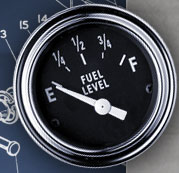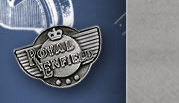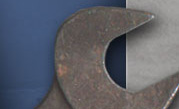
Episode 9 – "A Brief History of The
Rumble Rally"
Early in the last century a great legend was born. Not just any legend, but a
legend born out greed, political ambition and a publicity stunt. Indeed it was
the best kind of legend.
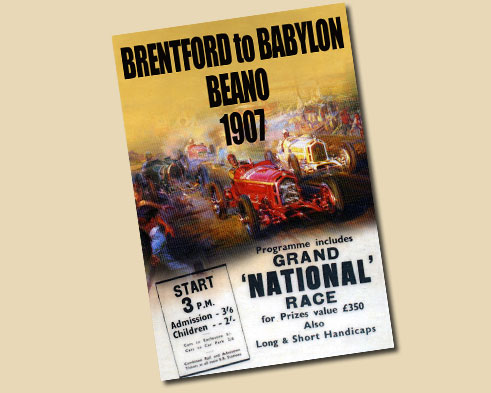
The Rumble Rally, as it is known today, is a race consisting
of stages held in numerous European cities and countries
either existing, extinct, or simply made
up to make the borders more interesting on a decorative wall map.
This is a fate commonly suffered by the tiny Kingdom of Carpania. Carpania’s
recognition on the map is only occasionally acknowledged when the less-than-decorative
borders of Europe need a frilly edge. One other example has to be the only
extreme race stage to take place in the Scottish Highlands. The stage had as
its designated starting point the picturesque village of Brigadoon. The stage
end of this section of the 1908 race looks just about ready for a result…sometime
in June of next year.
Back in those days the race was known as “The Brentford to Babylon
Beano” and was the creation of the eccentric media mogul Bordon Gannet
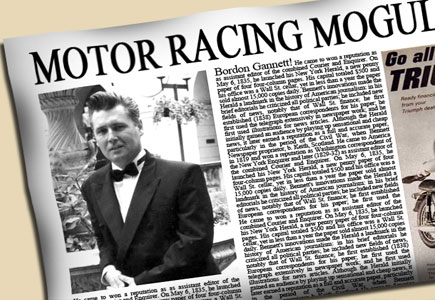
the owner of the largest
circulating national publications of their day – The Daily Bystander, The Weekend Busybody, The Curtain
Twitcher Fortnightly Review, and The Interloper Monthly Magazine. It was
Gannet’s idea to hold a race sponsored by his publishing empire to
publicise the newspapers’ first-class reporting abilities and increase
circulation, or so the public were lead to believe… .
The first race was just a speed trial for motorized vehicles travelling between
two cities, but as the popularity of motor racing grew so did its various competitions,
its competitors and the prizes on offer. The first of Gannet’s international
rallies was run in 1906 with a collection of multinational entrants all extremely
eager to win the large cash sum put up by the race organizers as the top prize.
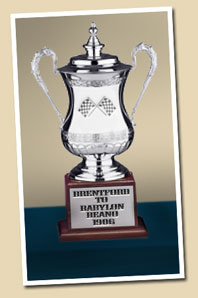
So
eager were the entrants that underhandedness was rife amongst the competing
teams, and it was suggested
that some sort of sportsmanship-like ruling should be introduced for dignity’s
sake. This suggestion was quickly dismissed, and the spoil-sporting goody-two
shoes who offered it was taken ‘round the back and permanently silenced.
After all, it would take all the fun out of everything.
The race had become a way for squabbling foreign powers to test new technology
and ‘secret weapons’ on each other in a fair and square sporting
situation. May the best man or most certainly the best “tooled-up” man
win and all that sort of thing.
Even when a little smattering of war broke out in 1914 the rally continued,
but not in a publicly observed manner. So as not to attract the unwanted gaze
of the public during the war, the competition race vehicles were painted olive
drab with the addition of a red-cross symbol and a number. This afforded some
air of legitimacy to their appearance of rushing off hither and thither.
The rally continued in an underground manner with the bickering countries
trying to get the better of each other by using celebrity spies as race correspondents
and agents for the race organisers. “Baron” von Richthofen a.k.a. “The
Red Baron” or “Manny” to his chums, spent the second half
of the war buzzing race competitors in his Fokker triplane.
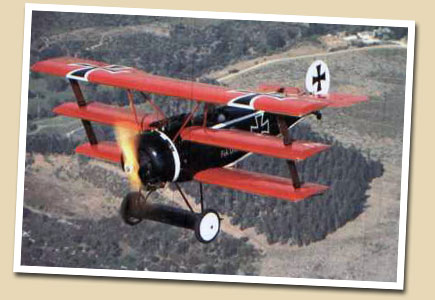
His highly confidential mission was not to casually pick
off allied aircraft, but to fatally disrupt targeted allied entrants in the
race. One other such
race disruptor was the self-styled faux-exotique Dutch strumpet Ms. Mata
Hari.
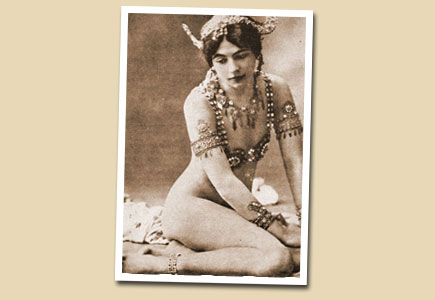
Mata, who’s treasured lucky girdle is still cherished
by her ancestral successor Miss Kitten Kaboodle, set hearts and fists of
cash aflutter when she indiscreetly adjusted said garment at the start line
of the
Paris stage of the Rally in 1916, thus causing a pile up of eight of the
twenty-three vehicle line up.
After the Great War the Gannet Publishing Empire collapsed suddenly like a
Las Vegas casino past its final spin of the roulette wheel. It is said that
the organizers of the Rally were never really part of Gannet’s Empire – that
was just a front for the real people in power and in control. Powerful people
like perhaps… The Hooded Claw!
By 1950 when the frost of the Cold War was beginning to form on the windowpanes
of the world, the award had gone beyond just a simple extravagant cash prize
and escalated to what can only be described as a “wish” to be granted
by the winning entrant/team’s government. The winner, in other words,
was granted his heart’s desire if he won the race and thus gave his country
a higher placement in the New World Order stakes. This was no less than gambling
on a higher plane for international power, and so much more fun than just the
Illuminati drawing straws or potentates playing “my bomb’s bigger
than yours.”
Eventually the public face of the Rally was forgotten or “rubbed out” if
you will. However, the race remained quite active on the highways and byways
of the Underworld, only visible to conspiracy theorists, dogs, and small inquisitive
children. Here it has remained ever since as if in a fifth dimension or another
time/space continuum thingy. Just because it is not seen does not mean that
it doesn’t happen.
Reporting of the race progress and results can be found with a certain amount
of patience, a little know-how, and a large sum of cash. They are obscured
by being written in code in the want ad section of the International Herald & Tribune.
Just look out of the corner of your eye for the word “Mesopotamia,” insert
your tongue in your cheek, and read on… .
Excerpts from The Official Rally Rule Book and Code of Conduct
Competitors are each given specific starting orders with independent route
maps. Not all competitors receive the same routes. Nothing is fair in rallies
and war.
Competitors may be scored based upon how well they follow their assigned route
as prescribed by the Organisers. And then again, they may not. Don’t
like it? Tough.
All Competitors must abide by the rules set at the beginning, middle, and
end of the race. The Organisers of the race reserve the right to change the
rules as and whenever it pleases them. Failure to comply can and will result
in penalties on a scale of “Minor Infraction,” “Major Flouting,” and “Really
Impressive Rule Breaking Tactics.” The penalties will be in the form
of a physical, mental, or monetary punishment.
Examples of physical punishments are: handicapping the competitor, handicapping
the vehicle, moving the competitor and/or vehicle to another location (and
not always with the aide of an engine), the removal of a wheel, tampering with
the brakes, obscuring the competitor’s vision with perhaps a blindfold
and physical restraint, or imprisonment.
Examples of mental punishment are: sleep deprivation, character assassination,
destruction of confidence, emotion bashing, will breakage, psychological warfare,
and all manner of general scare tactics.
Examples of monetary punishments are: the competitor is man-handled into an
inverted position and violently shaken to loosen spare change, “controlled
mugging” or an on-the-spot fine, the selling of a competitor’s
soul to Beelzebub (once only…), or an agreement to hand over a first
born child (which in most countries is still recognised as a genuine commodity,
especially if it’s not yours).
Stages
At the beginning of each stage of the Rally, each Competitor is given or must
find his clue, tip, or rule change to allow him to proceed with his race orders
and complete the Stage. Detours may occur at anytime – BEWARE! During
each stage of the race, all expenses (food, transportation, fuel, lodging,
bribes and supplies) must be funded independently by each Competitor or a Competitor’s
Sponsor. Competitors can beg, borrow, steal or sell possessions/favours whilst
attempting not to find themselves bribeless and on the wrong side of the local
law. Any claims of robbery, highwayman intervention, compromise of reputation
or kidnapping must be submitted to the Organisers in writing – if you
can find them… .
The clues/tips found by Competitors in each stage point the Competitor to
the next stage destination or direct them to perform a task set by the Organiser.
Route marker flags mark the places where Competitors must go to find clues
and tips (this is of course open to suggestion and sabotage. You’ve
been WARNED!). Most route markers will be associated somehow with cafes,
bars, clubs, pubs, hotels, hostelries, shops, dens of iniquity, and public
toilets. Flags are easily recognised by their depiction of the Rally’s
official logo.
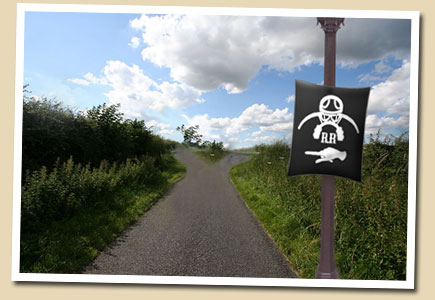
Stage End is the final destination in each Stage of the Rally. Competitors
depart for the next Stage of the race at the time they arrive at the end
of the previous stage plus 12 hours, minus any hours levied for penalties,
plus any hours awarded for performance, and minus any time spent in the
custody of the local constabulary – thus allowing a generous amount
of time for rest, replenishment, and repairs. The last Competitor to arrive
at the
Stage End is eliminated from the race. The manner of elimination is open
to interpretation and can be severely lessened if a substantial bribe is
forthcoming.
Dangers & Warnings
(Yes, and if you’re lucky)
Handicapping, Sabotage and general Jiggery Pokery is allowable at all times.
Competitors/Teams are progressively eliminated until only three teams are
left. The three Competitors/Teams will remain competing in the final Stage
of the race; the first Competitor to reach the “finish line” fully
conscious wins the race and is awarded a “fabulous prize” by the
race Organisers.
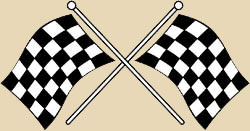
Let the race begin!
